Dracula (2020)
Directed by: Damon Thomas, Jonny Campbell, Paul McGuigan
Written by: Mark Gatiss, Steven Moffat
Starring: Claes Bang, Corrina Wilson, Dolly Wells, Matthew Beard
UK
AVAILABLE ON NETFLIX NOW, AVAILABLE ON BLU-RAY AND DVD February 3rd
RUNNING TIME: 3 x 90 mins
REVIEWED BY: Dr Lenera, Official HCF Critic
MAJOR SPOILERS!
Jonathan Harker turns up at a nunnery in Hungary, bruised, drained and very frightened. He tells Sister Agatha of how he, a solicitor, went to Castle Dracula in Transylvania to sort out its owner Count Dracula’s purchasing of Carfax Abbey in England, and soon found himself imprisoned in a place which seems to have horrors beyond every door, by a demonic man who gradually sucked his blood out. Eventually he escaped to what seemed like safety – but now the Count comes calling. These nuns seem quite prepared to take on the forces of darkness, but Harker is now basically a vampire himself, and what of Mina, his fiancee….
If you’ve been reading this website for long enough, then you’ll have read many reviews of Dracula films written by me, and will have probably deduced that Yours Truly is a huge fan. Therefore you’ll understand both my excitement and apprehension when the news broke that Steven Moffat and Mike Gatiss were penning a new adaptation, two writers whom I kind of have a love/hate relationship with. At their best, they’re extremely sharp, witty and fresh, but at their worse they’re either rather smugly screaming “look how clever we are” at the top of their voices, or obsessed with political correctness, often ramming stuff down people’s throats. But they’re both Gothic horror fans, and even when it became clear that this wasn’t going to be particularly close to Bram Stoker’s novel, it was hard to see that as a problem. It’s generally acknowledged that Bram Stoker’s Dracula is the only faithful version, and indeed if you take out the love story the book is pretty much there intact, but we’ve also had a much older BBC Dracula from 1977 that was extremely close, and both versions of Nosferatu followed the first two thirds of the book pretty well, plus that dodgy 1970 one from that ‘master of cinema’ Jess Franco. And probably a few others I haven’t thought of. A very quick glance at the IMDB comment reviews indicates that a lot of people are mighty pissed that Stoker hasn’t been closely followed, but much like A Christmas Carol [the latest version of which has which has sparked even more divisive reactions, and which I intended to review but just didn’t have time], surely a great story such as this should have new takes on it to maintain interest? Mind you, there’s also the fact that BBC adaptations have hardly been all quality of late, the stink of The War Of The Worlds being particularly strong.
Well, for the most part, this Dracula turned out to be a cracking version, with the love that Moffat and Gatiss have for the subject really showing through. It indeed only follows a very vague outline of the story most of us know, preferring to tweak or change totally many aspects, but quite often it’s so well done that one becomes excited as each new plot element is about to come up to see what has been done with it. It takes things down some interesting pathways while continually showing an awareness of past versions without falling into the trap of slavish quoting. It has some really memorable scenes of horror and a fine feel for the Gothic. I say all this – and must then say – For The First Two Episodes. Because for episode three, it then decided to follow the recent trend for disappointing finales and almost totally botch things, and as I type I just can’t fathom what our duo of writers were trying to do here. The premise of the finale, which is to loosely retell the second half of the novel in the present day, certainly had potential – just consider how well Sherlock came off, at least for its first two seasons and a bit. And it’s not as if this is the first time Dracula has turned up in modern times. Hammer did it twice, and also had a descendant of his nemesis Van Helsing as we do here. But it soon loses itself in a mass of half baked ideas, coincidences and variations on Stoker that all needed a hell of a lot more than an hour and a half within which to work, and for most of the time there’s not even any attempt to be scary or exciting any more. It seems like they were going for a more dialogue-heavy, cerebral approach, something that certainly worked for Sherlock, but – come on now – this is Dracula! Stoker’s novel may be well written [far more so than Mary Shelley’s Frankenstein] and be literally crammed with subtext, but it’s still basically pulp, and to try to make it more just does it a disservice.
However, there is still much to praise, and one of the most praise-worthy aspects is Dracula himself. Okay, when he’s as an old person at the beginning Claes Bang can’t do an accent that sounds anything like Transylvanian – in fact he sometimes sounds oriental [which sounds ridiculous I know], which makes it a good thing that he has a perfect English accent when he becomes young and virile. But after this he’s really good. I had visions of an out of place James Bond-style quipper who would be quite sympathetic, but the sardonic indifference this smooth talker who absorbs the minds of victims has to the horror he creates helps to show a truly nasty personality which is certainly in keeping with the character that Stoker wrote about. When asked why he’s just driven a stake through one of his ‘brides’, he replies casually, “because I wanted to see if she would die, I suppose”. Some of his other lines are more conventionally jokey, but most of them work in the context of this Dracula having so much fun being evil, and even as far back as 1931 Bela Lugosi uttered, “I never drink…wine” so this is hardly a travesty of the character’s legacy. This Dracula is still frightening, and for my money Bang deserves to be placed up there with the likes of Lugosi, Christopher Lee, Gary Oldman and Klaus Kinski. However, what they’ve done with somebody else is far less successful. The cause of gender balancing has resulted in Van Helsing now being a mostly [she seems to flit] atheist nun who says things like, when asked who she is by Dracula, “your worst nightmare, an educated women with a crucifix”. The character is ludicrous and Moffat and Gatiss are so in love with her that they have her almost continually on screen, something which threatens to unbalance the narrative at times. Fortunately Dolly Wells is mostly good at playing the part and delivers the amusing lines that she’s often given in a nicely dry fashion, but she struggles accent-wise too – every now and again it sounds like there’s some Irish in there.
Opening with Harker in the monastery having escaped from Castle Dracula starts things off in a dramatic fashion, as does Sister Agatha asking Harker if he “had sex with Count Dracula”. There’s a bit soon after where Mina in a letter jokingly hints that she may seek solace with a barmaid which smacks of BBC dictates, but Dracula being bisexual? – well there’s a gay undertone to much of the opening section of the book anyway, so having Harker dream of Mina turning into Dracula during sex was no problem for me. For a while things play out like the novel which entirely takes the form of letters, though some of the material at the castle might have had more atmosphere without Harker’s narration. However, we’ve never seen Castle Dracula have interiors as dark as we have here, any light coming from lots of candles in some quite beautiful photography from Tony Slater Ling. The idea of the place designed as a maze by a mad architect, perhaps inspired by The Phantom Of The Opera, is neat, and it soon becomes really fun seeing what variations on familiar situations will come along. It’s disappointing when the expected encounter between Harker and several sexy female vampire ‘brides’ is replaced by a meeting with some vampires of a much uglier kind – until you then do get a really effective scene with a female bloodsucker, climaxing with the horrifying revelation of a vampire baby. Harker is killed by Dracula, only to come back to life in a truly agonising manner that is genuinely chilling. The revelation as to what Harker has been writing provides a nice variant on a favourite Shining moment, and when Dracula comes calling confrontations have a real intensity to them. By now, Van Helsing aside, I was really impressed with what Moffat and Gattis were doing, and couldn’t wait for part two.
Now I’ve often thought how there could be a film that extends the section of the novel set aboard The Demeter, the ship headed for Whitby which becomes a ghost ship due to Dracula being on board. Well, Moffat and Gatiss must have heard me, because that’s what they gave us, with some original characters being introduced about to take the fateful voyage. Boy is the Beeb’s diversity agenda working overtime here, but I’ll move on to the puzzling scenes of Dracula and Van Helsing playing chess which I guess are supposed to be taking place in Van Helsing’s mind but which don’t really add anything. In fact there really are too many confrontations between the two throughout the mini-series – one should be looking forward to see these scenes, not sighing when yet another one comes up. There are some really good touches to this episode though, like Dracula picking up on people’s vulnerabilities so he can get close to them, his charm being brilliantly showcased. Not quite enough is made of the setting, a setting that quite a few other horrors – even ones like Ghost Ship and Friday The 13th Part 8: Jason Takes Manhattan – wrought more from, and the green-dominated look doesn’t help – surely we needed more darkness? But the tension is certainly maintained, and one must give both the writers and the producers credit for making this episode very different to the first one in a mini-series that unusually has a different director for each part. And then, we have Dracula reaching Whitby – but today’s Whitby – to be met by police cars and helicopters – and all I could think of was Monty Python And The Holy Grail. However, once the shock had gone, I realised that having Dracula loose in today’s time could be very good indeeed – yes it’s been done before but never really well.
Well, we start off well with another of those nasty scenes with some black comedy that these writers can do so well, with a woman faced with Dracula in her kitchen and her husband in the fridge. Dracula’s comment on how he feels like he’s experienced luxury for the first time seems like we’re in for some pointed jabs at life in the modern world, but that’s all we get unless you count having some of the expected fish out of water stuff and much of the ensuring action tediously taking place on mobile phones. There’s lots of nightclub footage along with an awkward approximation of how young people might talk, a Dracula who’s imprisoned for almost half of the episode, and the sense of trying to cram hours’ worth of material into a ridiculously short space of time. Most of the missing characters from the book turn up, Wells reappearing as a descendant of Van Helsing. Lucy’s wilful transformation into a vampire and her grotesque disfigurement may have been involving and even moving if we’d been given a chance to get to know her, but instead there’s a strange whiff of slut shaming about it, more than in any other version. Gatiss himself is fun as a sleazy Renfield, but by the time we get to both Van Helsings appearing together [one often appearing isn’t enough], cancer being introduced, and a desperate re-enacting of Peter Cushing’s iconic curtain pulling bit at the end of 1958’s Dracula during the climactic chat [what else would it be?] between Van Helsing and Dracula, one is left with the impression that our stalwart scribes got rather lost – or the money ran out. The final scene tries to be romantic, but it seems to come out of absolutely nowhere and therefore doesn’t move or indeed work in any way at all. Extremely stylish cinematography from Ling with some lovely use of colour fails to make up for the feeling of crushing disappointment.
There are a few early nods to Bram Stoker’s Dracula, and I was pleased to see my favourite Hammer Dracula Dracula Prince Of Darkness being leaned on a bit in the second half of the first episode, though with no actual copying of scenes. Vampirism is now a horrible, painful experience for Dracula’s victims, not romantic in any way shape or form. The idea of vampires looking ‘normal’ in reflections, giving them a false impression of how hideous they are, is perhaps the most effective of the changes to familiar vampire lore. Dracula’s fear of the cross possibly being because of all the god-fearing peasants he’s bitten is an even more interesting and rather subversive idea, but it’s later ruined by it later being boringly discovered that Dracula’s real fears are shame and fear of death. There’s certainly plenty of the red stuff throughout, and a few surprisingly strong moments [like Dracula wearing another’s skin] that would have probably garnered loads of complaints a couple of decades ago, but the show is oddly coy about showing staking – it always cuts away – and one scene showing the emergence of Dracula from a dog looks half-finished. At least some practical effects seem to mix with the digital stuff, and I don’t know if the shoddy bat scenes were meant to recall the similarly crappy bits in Kiss Of The Vampire, but they brought a smile to my face anyway. Indeed this Dracula lover did smile very often throughout its first episode and indeed its second, but he can’t help feeling that Moffat and Gattis ended up achieving in just three episodes what they managed to do in Sherlock [a series that started absolutely wonderfully and then gradually disappeared more and more up its own arse] over a much longer period of time – and that’s not a feat worthy of praise. In fact towards the end it felt like they weren’t even trying very hard, or just ran out of inspiration. It’s very baffling. Maybe they will realise how badly wrong they went and do episode three all over again? One can dream.
Rating: 










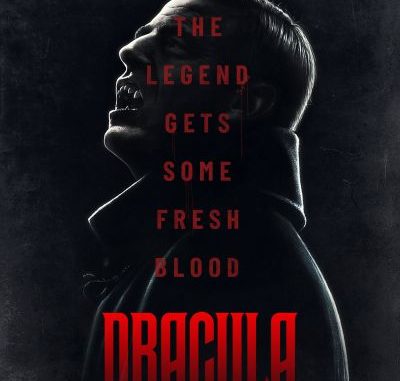
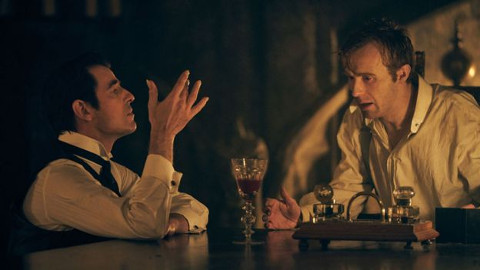
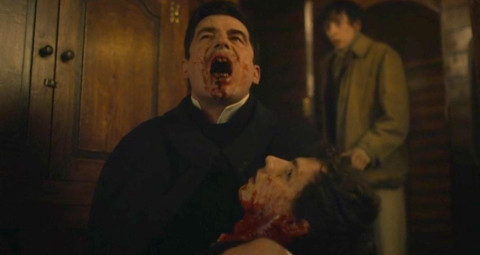
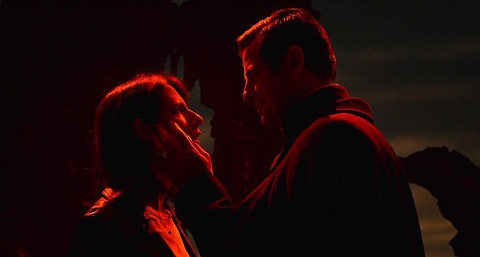


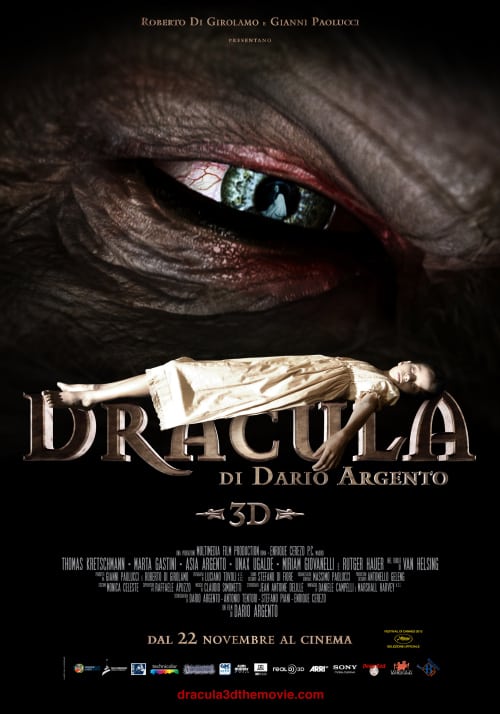
The third episode was actually shot by episode 1 Cinematographer Tony Slater Ling “ Extremely stylish cinematography from [this time] Julian Court with some lovely use of colour fails to make up for the feeling of crushing disappointment.”
Thank you for the correction sir.